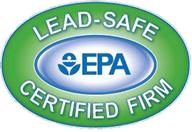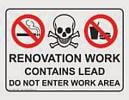RRP Question: Does Removing Aluminum Siding Fall Under the RRP Rule?
Question:

"Theoretically, aluminum siding came with paint on it…..and most was installed before 1978. Does anyone know if the factory paint on aluminum siding has lead in it? Intuitively, one would pull it off without concern for lead, but I have a client who has asked specifically."
Gregory A. Antonioli, GCP, President
Out of the Woods Construction and Cabinetry
Shawn’s Answer:
Greg:
 The rule includes all painted or coated surfaces. So yes, the siding must be assumed to have lead until tested otherwise.
The rule includes all painted or coated surfaces. So yes, the siding must be assumed to have lead until tested otherwise.
Note: My opinion as expressed above is based on the fact that the painted surface is being “disturbed”. Here is an interesting conversation about this topic on the JLC forum.
Aluminum siding during that era was manufactured by many different companies so it would not be wise to assume they all used the same paint or coating. Even if you test a product on one house and find it lead free, under the RRP Rule you must assume that same product might have lead if installed on any other building.
Here is one that might seem crazy. Along the same vein, even if you built an addition or deck at a home after 1977, and you know all the products you used were purchased and installed after 1977, if returning to work on the addition or deck you must still assume the addition or deck may contain lead. The only way around this is to test it to prove the absence of lead under the rule.
Something often missed or overlooked is if the original siding under the aluminum siding contains lead. If you have to remove that siding too or even just disturb more than 20 square feet of the old siding when removing the aluminum siding, then the RRP Rule will apply.
Here is what the EPA says at their RRP FAQ area about removing aluminum siding:
Question:
I am removing aluminum siding from a pre-1978 home. The aluminum siding was nailed over the top of painted wood siding that tested positive for lead. The underlying painted surface is greater than twenty-square feet. Must I comply with the Rule when removing the aluminum siding?
EPA Answer:
 The work practices for exterior projects are based on a performance standard – if the activity disturbs a painted surface (generally, by creating paint chips or dust) in excess of 20 square feet, the work area must be contained so that dust or debris does not leave the work area while the renovation is being performed. In this case, if the removal of the aluminum siding results in the disturbance of paint in excess of 20 square feet, then the RRP Rule applies. However, if the removal activity could be performed in such a way that does not disturb 20 square feet of painted surface, then the RRP Rule would not apply.
The work practices for exterior projects are based on a performance standard – if the activity disturbs a painted surface (generally, by creating paint chips or dust) in excess of 20 square feet, the work area must be contained so that dust or debris does not leave the work area while the renovation is being performed. In this case, if the removal of the aluminum siding results in the disturbance of paint in excess of 20 square feet, then the RRP Rule applies. However, if the removal activity could be performed in such a way that does not disturb 20 square feet of painted surface, then the RRP Rule would not apply.
EPA recognizes that this may be difficult to determine in advance of the renovation activity. However, the renovator is the person with the expertise and experience to make this determination on a case-by-case basis. In such a situation, a renovator should consider how factors like the condition of the underlying paint or the chosen method of removal may increase or decrease the likelihood for a disturbance of paint. If there is still uncertainty, EPA recommends that renovators err on the side of caution and be prepared to contain any dust and debris.

 Looking for accurate information about the EPA RRP rule?
Looking for accurate information about the EPA RRP rule?  Actually this is about helping spread the word to children and parents about avoiding the dangers of lead exposure.
Actually this is about helping spread the word to children and parents about avoiding the dangers of lead exposure.  I suggest renovators could use this video on their website. Consider creating an area on your site dedicated to the RRP Rule. Make it a place that offers information, advice and links that would help visitors understand the rule and the realities of lead exposure. If you do so you can send prospects and customers to your site to help pre-educate them prior to a sales call or before beginning work at their home.
I suggest renovators could use this video on their website. Consider creating an area on your site dedicated to the RRP Rule. Make it a place that offers information, advice and links that would help visitors understand the rule and the realities of lead exposure. If you do so you can send prospects and customers to your site to help pre-educate them prior to a sales call or before beginning work at their home. 

 In this example, I would place 3.5 mil plastic (from Home Depot), instead of the 6 mil plastic 10 feet out on the ground. Then, I would make sure doors/windows were closed, put plastic over any doors and then put up the warning sign. I would also run a plastic runner out to the dumpster and surround the ground around the dumpster with plastic. Doing the containment this way, saves me from having to wrap, bag or HEPA vac the siding (or myself). This is because I can dump the siding without ever going outside the containment area.
In this example, I would place 3.5 mil plastic (from Home Depot), instead of the 6 mil plastic 10 feet out on the ground. Then, I would make sure doors/windows were closed, put plastic over any doors and then put up the warning sign. I would also run a plastic runner out to the dumpster and surround the ground around the dumpster with plastic. Doing the containment this way, saves me from having to wrap, bag or HEPA vac the siding (or myself). This is because I can dump the siding without ever going outside the containment area. I can demo the tile, tub, shower, toilet and remove the demolition debris without doing any RRP. After that has been done, I cover up ducts with plastic, make sure windows are closed, close doors and cover with plastic, put up a warning sign and then cover the subfloor with plastic (6 feet out from where I will be working).
I can demo the tile, tub, shower, toilet and remove the demolition debris without doing any RRP. After that has been done, I cover up ducts with plastic, make sure windows are closed, close doors and cover with plastic, put up a warning sign and then cover the subfloor with plastic (6 feet out from where I will be working).  It very well could be that if you did a little homework by reading the actual law, you could reduce the cost of compliance on many jobs to less than 5%. Few contractors will lose a job because they are higher by less than 5%. Plus, with the cost less than 5%, I don’t even mention RRP to my clients during the estimation process anymore, which has helped to improve sales.
It very well could be that if you did a little homework by reading the actual law, you could reduce the cost of compliance on many jobs to less than 5%. Few contractors will lose a job because they are higher by less than 5%. Plus, with the cost less than 5%, I don’t even mention RRP to my clients during the estimation process anymore, which has helped to improve sales.  I suggest the real problem is that the original rule was poorly conceived and poorly written. Because we are now stuck with it, the proposed amendments are really just band-aid approaches to try to make it better for or more palatable to those affected by the rule. What we really need is a new well thought out rule to replace the existing rule, with the input and leadership of the industry this time. And, the industry needs to be proactive this time in its writing, its content and its enforcement.
I suggest the real problem is that the original rule was poorly conceived and poorly written. Because we are now stuck with it, the proposed amendments are really just band-aid approaches to try to make it better for or more palatable to those affected by the rule. What we really need is a new well thought out rule to replace the existing rule, with the input and leadership of the industry this time. And, the industry needs to be proactive this time in its writing, its content and its enforcement. Not using lead safe practices on a pre 1978 property is a big risk. Unless the house is pretested before renovations there is no point of reference regarding existing contamination. If lead safe work practices are not used, how will the business prove it did not cause the contamination?
Not using lead safe practices on a pre 1978 property is a big risk. Unless the house is pretested before renovations there is no point of reference regarding existing contamination. If lead safe work practices are not used, how will the business prove it did not cause the contamination?

 So it appears that a non-certified firm can do the work if testing that proved no lead was found was done by someone else, as long as the determination was made by a certified lead inspector or risk assessor, or by a certified renovator using an EPA recognized test kit and following the kit manufacturer’s instructions. The key is however, that the non-certified firm must have written proof from the person or business that did the testing that there is no lead in the work areas to be disturbed.
So it appears that a non-certified firm can do the work if testing that proved no lead was found was done by someone else, as long as the determination was made by a certified lead inspector or risk assessor, or by a certified renovator using an EPA recognized test kit and following the kit manufacturer’s instructions. The key is however, that the non-certified firm must have written proof from the person or business that did the testing that there is no lead in the work areas to be disturbed.



 When you remove all the smoke and mirrors from this rule, the EPA can prove two thoughts; 1 Some remodeling activities create dust 2 Lead paint dust can create or raise EBLL’s Independent of each other those two statements can be proven, but the combination (which is a major foundational reason for RRP) is not so clear. Why?
When you remove all the smoke and mirrors from this rule, the EPA can prove two thoughts; 1 Some remodeling activities create dust 2 Lead paint dust can create or raise EBLL’s Independent of each other those two statements can be proven, but the combination (which is a major foundational reason for RRP) is not so clear. Why? Since I can’t explain to the customer the need for this rule, I encourage my customers and prospects to contact their state and federal representatives and ask them to provide facts and figures to explain the need for the RRP rule. To assist them with this, I supply them with a letter to send to their representatives along with a stamped and addressed envelope. I encourage all other contractors to consider doing the same.
Since I can’t explain to the customer the need for this rule, I encourage my customers and prospects to contact their state and federal representatives and ask them to provide facts and figures to explain the need for the RRP rule. To assist them with this, I supply them with a letter to send to their representatives along with a stamped and addressed envelope. I encourage all other contractors to consider doing the same. 
 How we all choose to respond to the EPA’s oversight of the remodeling industry is a personal one. I will be the first to admit that initially I found it difficult to understand how invisible dust particles can cause serious health hazards. But with a little research, I got it. I suggest you can understand it too. Take my word for it, or look it up. I’m sure you will come to the same conclusion.
How we all choose to respond to the EPA’s oversight of the remodeling industry is a personal one. I will be the first to admit that initially I found it difficult to understand how invisible dust particles can cause serious health hazards. But with a little research, I got it. I suggest you can understand it too. Take my word for it, or look it up. I’m sure you will come to the same conclusion. The business part turns me on right now. However, I understand that there are those who prefer the hands on, the nail gun and the saw. I happen to prefer the keyboard and the pen. Having this new RRP rule is a huge challenge to incorporate into any business and I feel many of the same pressures you do. I believe following the rules and separating my business from others will take me to the next level of success. I also understand there are those who are seeing it from a totally different perspective.
The business part turns me on right now. However, I understand that there are those who prefer the hands on, the nail gun and the saw. I happen to prefer the keyboard and the pen. Having this new RRP rule is a huge challenge to incorporate into any business and I feel many of the same pressures you do. I believe following the rules and separating my business from others will take me to the next level of success. I also understand there are those who are seeing it from a totally different perspective. There is a sufficient body of scientific evidence that lead dust is created during renovation and while disturbing lead based painted surfaces. There is also a significant body of medical knowledge that lead is bad for people. I am educating my perspective clients as fast as I can. To the extent that they get it, and see a value in what I offer, I will be a clear choice for those who live in Pre 1978 homes.
There is a sufficient body of scientific evidence that lead dust is created during renovation and while disturbing lead based painted surfaces. There is also a significant body of medical knowledge that lead is bad for people. I am educating my perspective clients as fast as I can. To the extent that they get it, and see a value in what I offer, I will be a clear choice for those who live in Pre 1978 homes. One Person’s Opinion: This is a guest blog submitted by Paul Lesieur to express his opinion. Paul is a Yankee trained craftsman and the founder of
One Person’s Opinion: This is a guest blog submitted by Paul Lesieur to express his opinion. Paul is a Yankee trained craftsman and the founder of 


 Don’t get me going about the “Small added costs” and that the EPA plans to “encourage” consumers to choose only contractors who are Lead-Safe Certified. Wouldn’t it have made sense and have helped those businesses complying with the rule to have done the outreach and education before and as the rule went into effect? Wouldn’t have made sense to “require” consumers choose only contractors who are Lead-Safe Certified?
Don’t get me going about the “Small added costs” and that the EPA plans to “encourage” consumers to choose only contractors who are Lead-Safe Certified. Wouldn’t it have made sense and have helped those businesses complying with the rule to have done the outreach and education before and as the rule went into effect? Wouldn’t have made sense to “require” consumers choose only contractors who are Lead-Safe Certified?




